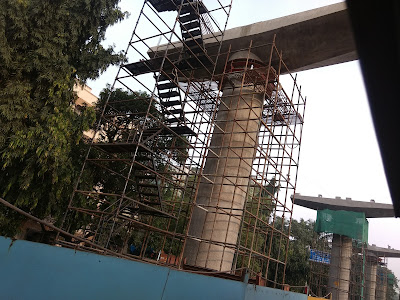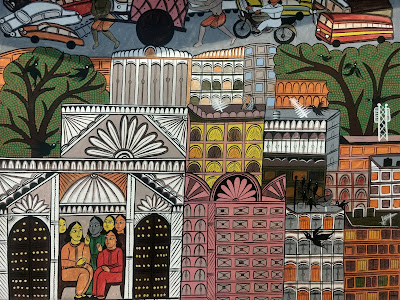Friday, January 05, 2018
Three Brutalisms: Shanghai
Diagram for a paper:
Three Brutalisms in Shanghai, China
Three Brutalisms in Shanghai, China
- Longchang Apartments -former jail turned into residential space
- 1933 - former slaughterhouse turned into a tourist centre
- Former neighbourhoods being gentrified and the takeover by edifices of capitalism
| Longchang Apartments, Shanghai |
| 1933 Slaughterhouse, Shanghai |
 |
| Li long type apartments with the high rise development, Shanghai |
Kitsch
Here is celebration of kitschy art at the Terminal 2 airport in Mumbai. I wonder why the curator felt that it was important to fill up every inch of space with some art or the other from some part of India. The orgy of ornament is suffocating! Over long forced walks at the T2, one is expected to brush along works that seem disparate and connected at the same time!
Over several ins and outs of T2 now, I am compelled to buy into Prasad's (Shetty) argument that the new airport is quite poor as a functional resolution - one that makes you walk much more than others, some times more than a kilometre to get to places of priority. One is baffled by the magnanimity of the airport for no real reason! Besides, as a public facility, as Prasad pointed, the airport becomes more and more cumbersome as it pushes access to public transport to the corner, and levies taxis and services a heavy parking or entrance charge! Setting itself aloof from the city, it becomes an exclusively private entity, for the elite to savour.
Prasad draws attention to the diagrams of several airports to critique T2. For those traveling once in a while, the new Mumbai Airport may be an experience. However, for regular commuters, the sheer redundancy of circulation within which the art work and plastic landscape is accommodated can become quite tedious. The airport makes you go up and down and pushes you through a humungous shopping plaza that you aren't necessarily ready to engage with. Besides, the long walks and the pressure to reach to the boarding gates in time never leave you with any room for standing and gazing by the overflowing artworks along the airports.
Nevertheless, there is no question that architecturally, the building is well detailed - but you leave it thinking -- at what expense?
Over several ins and outs of T2 now, I am compelled to buy into Prasad's (Shetty) argument that the new airport is quite poor as a functional resolution - one that makes you walk much more than others, some times more than a kilometre to get to places of priority. One is baffled by the magnanimity of the airport for no real reason! Besides, as a public facility, as Prasad pointed, the airport becomes more and more cumbersome as it pushes access to public transport to the corner, and levies taxis and services a heavy parking or entrance charge! Setting itself aloof from the city, it becomes an exclusively private entity, for the elite to savour.
Prasad draws attention to the diagrams of several airports to critique T2. For those traveling once in a while, the new Mumbai Airport may be an experience. However, for regular commuters, the sheer redundancy of circulation within which the art work and plastic landscape is accommodated can become quite tedious. The airport makes you go up and down and pushes you through a humungous shopping plaza that you aren't necessarily ready to engage with. Besides, the long walks and the pressure to reach to the boarding gates in time never leave you with any room for standing and gazing by the overflowing artworks along the airports.
Nevertheless, there is no question that architecturally, the building is well detailed - but you leave it thinking -- at what expense?
Kochi Biennale 2016 Favourites
Apologies for
1. Delayed Post
2. Bad photographs
3. No annotations
4. No explanations
5. Limited works
There was just so much to see at the Kochi Biennale 2016, and here's what I could mange to shoot with my scratchy phone camera and 10-year old dying Sony Cybershot. I realized later, immediately, that I needed to get both - my phone and camera fixed! Nevertheless, just for record, here are some works that moved me:
1. Delayed Post
2. Bad photographs
3. No annotations
4. No explanations
5. Limited works
There was just so much to see at the Kochi Biennale 2016, and here's what I could mange to shoot with my scratchy phone camera and 10-year old dying Sony Cybershot. I realized later, immediately, that I needed to get both - my phone and camera fixed! Nevertheless, just for record, here are some works that moved me:
Thursday, January 04, 2018
Constructs
I have been fascinated for long in the parapharnelia that are used to bring up buildings: Structures that emerge before those that we come to inhabit. A completely different series of bodies occupy it before us, quite differently than us. Giving the appearances of the infrastructures of very buildings, these are however only temporary, and come together in new configurations all the time depending on site conditions. Such built envelopes enable a building to finally take shape. They are transparent, porous, minimal, elegant, functional and crisp. Often, the buildings that they are built for fail to imbibe these characterists - becoming closed, heavy, cumbersome and frivilous.
We read them as lines - those that provide datum to perceiving the incomplete monster. Somehow, the scaffold is always complete, irrespective of the growing body behind. It scales the structure, offers a metric, graphs the canvas and inscribes the body of labour within. The strategy of the scaffold as the building is used in the city during several occasions including festivals, rallies, exhibitions, and so on. Yet, so much of it fails to register itself as building. If only one could reverse the process where buildings could dismantle themselves to leave behind the scaffold for us to inhabit; an architecture that becomes in the erasure of the other. What geometries do we employ to realize such space? How do we imagine this process?



Subscribe to:
Posts (Atom)





































